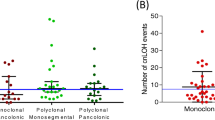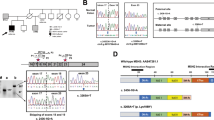Abstract
hMLH1 and hMSH2 can be considered tumor suppressor genes, as both alleles must be inactivated in order to lose the mismatch repair (MMR) function. In this regard, it has been proposed that LOH at MMR loci is a common Knudson's second-hit mechanism in HNPCC patients. However, experimental evidence supporting this view is scarcely found in the literature. We have performed a comprehensive analysis of LOH in 45 HNPCC tumors carrying a germline alteration in MMR loci. Overall, we have detected LOH at MMR loci in 56% of the cases. However, up to 40% of the LOH events targeted the mutant allele, arguing against a second-hit role in these tumors. Interestingly, the age at diagnosis was significantly older in these patients. To explain this and previous data, we propose a dual role for LOH at MMR loci in HNPCC.
This is a preview of subscription content, access via your institution
Access options
Subscribe to this journal
Receive 50 print issues and online access
$259.00 per year
only $5.18 per issue
Buy this article
- Purchase on Springer Link
- Instant access to full article PDF
Prices may be subject to local taxes which are calculated during checkout


Similar content being viewed by others
References
Ahuja N, Li Q, Mohan AL, Baylin SB, Issa JP . (1998). Cancer Res 58: 5489–5494.
Caldes T, Godino J, de la Hoya M, García Carbonero I, Pérez Segura P, Eng C et al. (2002). Int J Cancer 98: 774–779.
Cunningham JM, Christensen ER, Tester DJ, Kim CY, Roche PC, Burgart LJ et al. (1998). Cancer Res 58: 3455–3460.
De Jong AE, van Puijenbroek M, Hendriks Y, Tops C, Wijnen J, Ausems MG et al. (2004). Clin Cancer Res 10: 972–980.
De la Hoya M, Díaz-Rubio E, Caldés T . (1999). Clin Chem 45: 2028–2030.
Hemminki A, Peltomaki P, Mecklin JP, Jarvinen H, Salovaara R, Nystrom-Lahti M et al. (1994). Nat Genet 8: 405–410.
Herman JG, Umar A, Polyak K, Graff JR, Ahuja N, Issa JP et al. (1998). Proc Natl Acad Sci USA 95: 6870–6875.
Kane MF, Loda M, Gaida GM, Lipman J, Mishra R, Goldman H et al. (1997). Cancer Res 57: 808–811.
Konishi M, Kikuchi-Yanoshita R, Tanaka K, Muraoka M, Onda A, Okumura Y et al. (1996). Gastroenterology 111: 307–317.
Kuismanen SA, Holmberg MT, Salovaara R, de la Chapelle A, Peltomaki P . (2000). Am J Pathol 156: 1773–1779.
Leach FS, Nicolaides NC, Papadopoulus N, Liu B, Jen J, Parsons R et al. (1993). Cell 75: 1215–1225.
Lu SL, Akiyama Y, Nagasaki H, Nomizu T, Ikeda E, Baba S et al. (1996). Jpn J Cancer Res 87: 279–287.
Lynch HT, de la Chapelle A . (1999). J Med Genet 36: 801–818.
Miller SA, Dykes DD, Polesky HF . (1998). Nucleic Acids Res 16: 1215.
Osorio A, de la Hoya M, Rodríguez-López R, Martínez-Ramírez A, Cazorla A, Ganizo JJ et al. (2002). Int J Cancer 99: 305–309.
Papadopoulus N, Nicolaides NC, Wei YF, Ruben SM, Carter KC, Rosen CA et al. (1994). Science 263: 1625–1629.
Parsons R, Li GM, Longley MJ, Fang WH, Papadopoulus N, Jen J et al. (1993). Cell 75: 1227–1236.
Peltomaki P, de la Chapelle A . (1997). Adv Cancer Res 71: 93–119.
Potocnik U, Glavac D, Golouh R, Ravnik-Glavac M . (2001). Cancer Genetics and Cytogenetics 126: 85–96.
Tannergard P, Liu T, Weger A, Nordenskjold M, Lindblom A . (1997). Hum Genet 101: 51–55.
Veigl ML, Kasturi L, Olechnowicz J, Ma AH, Lutterbaugh JD, Periyasamy S et al. (1998). Proc Natl Acad Sci USA 95: 8698–8702.
Wheeler JMD, Beck NE, Kim HC, Tomlinson IPM, Mortensen NJM, Bodmer WF . (1999). Proc Natl Acad Sci USA 96: 10296–10301.
Wheeler JMD, Loukola A, Aaltonen LA, McC Mortensen NJ, Bodmer WF . (2000). J Med Genet 37: 588–592.
Yuen ST, Chan TL, Ho JW, Chan SY, Chung LP, Lam WY et al. (2002). Oncogene 21: 7585–7592.
Acknowledgements
This study was supported by the Fondo Investigación Sanitaria grant 04/0957; RTICC C03/10 and a grant from Bristol-Myers Squibb. A Sánchez de Abajo was a fellow of UICC (ICRETT Award No ICR/04/024/2004).
Author information
Authors and Affiliations
Corresponding author
Rights and permissions
About this article
Cite this article
Sanchez de Abajo, A., de la Hoya, M., van Puijenbroek, M. et al. Dual role of LOH at MMR loci in hereditary non-polyposis colorectal cancer?. Oncogene 25, 2124–2130 (2006). https://doi.org/10.1038/sj.onc.1209233
Received:
Revised:
Accepted:
Published:
Issue Date:
DOI: https://doi.org/10.1038/sj.onc.1209233
Keywords
This article is cited by
-
Update on Lynch syndrome genomics
Familial Cancer (2016)
-
The onset of p53 loss of heterozygosity is differentially induced in various stem cell types and may involve the loss of either allele
Cell Death & Differentiation (2014)
-
Partial loss of heterozygosity events at the mutated gene in tumors from MLH1/MSH2 large genomic rearrangement carriers
BMC Cancer (2009)
-
Genome-wide copy neutral LOH is infrequent in familial and sporadic microsatellite unstable carcinomas
Familial Cancer (2008)
-
No evidence for dual role of loss of heterozygosity in hereditary non-polyposis colorectal cancer
Oncogene (2007)



